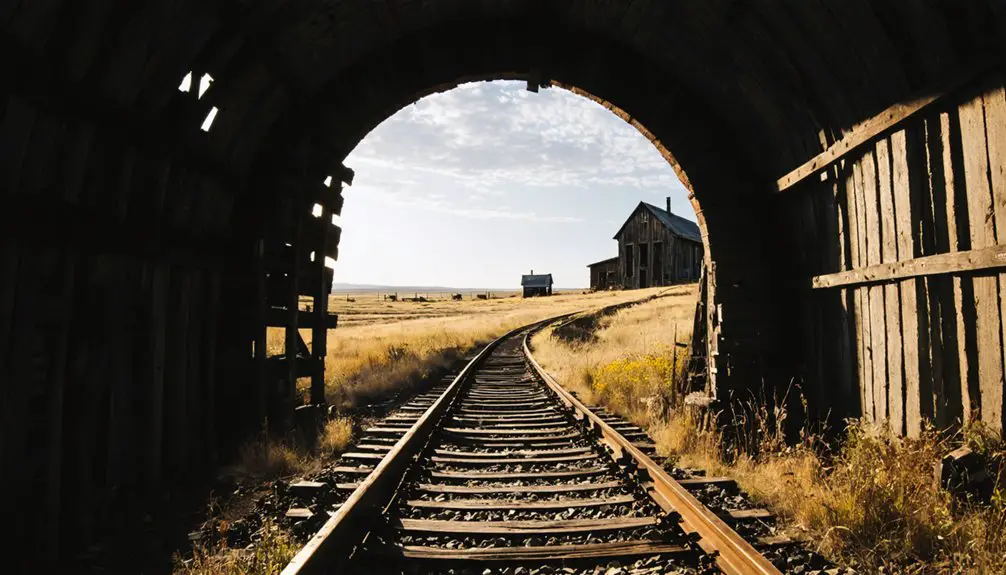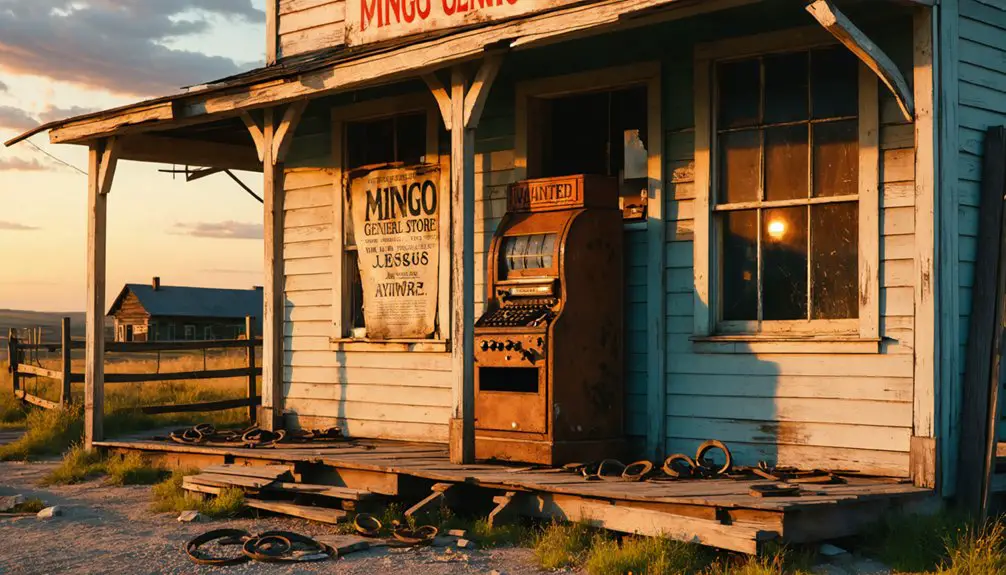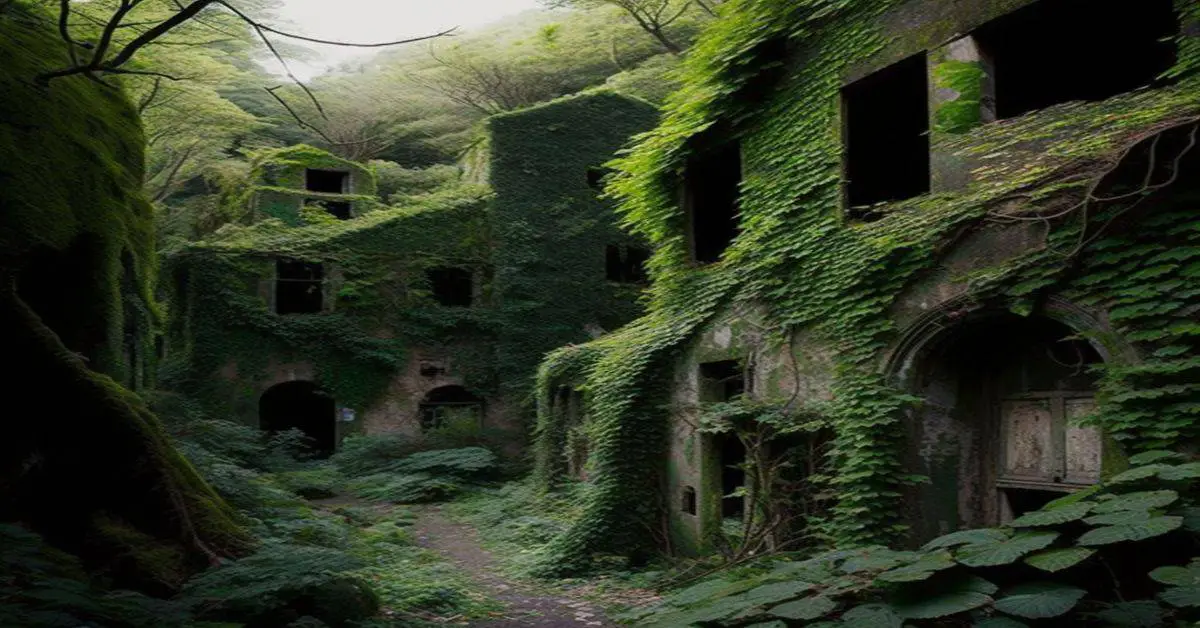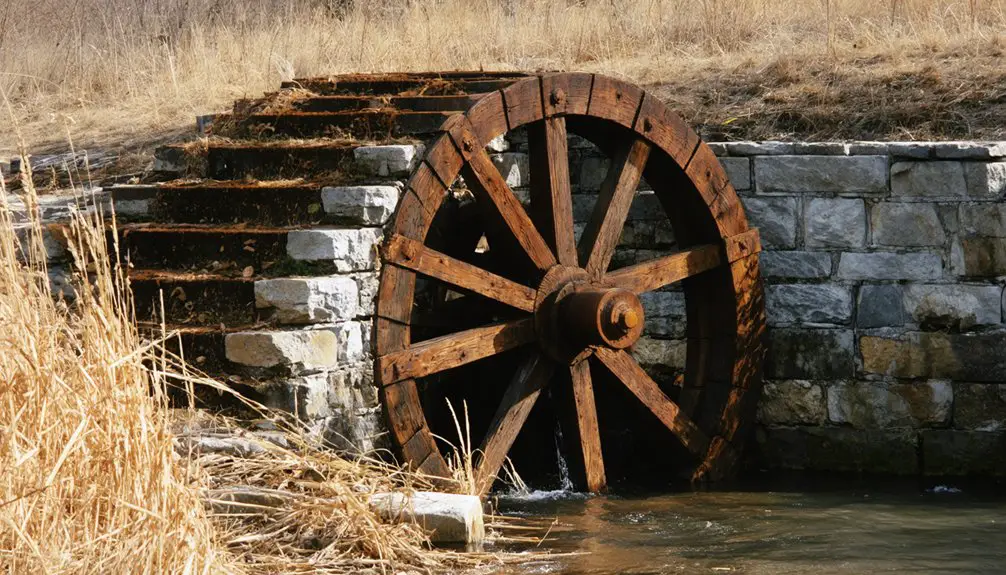You’ll find Mingo’s ghost town remains in Thomas County, Kansas, where it emerged as a strategic railroad hub in 1887. Originally named Thurford, the town flourished after Doc Misner convinced Union Pacific to relocate its station two miles north in 1893. The community thrived with wooden buildings, grain elevators, and mining operations until early 1900s economic shifts led to its decline. Mingo’s abandoned structures now tell tales of Kansas’s pioneering spirit and railroad legacy.
Key Takeaways
- Mingo, Kansas was established in 1887 along the Union Pacific Railroad line, initially named Thurford before becoming a significant agricultural hub.
- Doc Misner’s relocation of the railroad station in 1893 shaped the town’s development, leading to careful community planning in 1907.
- The town’s economy relied heavily on mining operations and railroad transportation, with coal mining peaking between 1900s and 1940s.
- Mingo’s decline began in the early 1900s when cheaper coal discoveries elsewhere led to population exodus and economic downturn.
- The closure of the post office around 1871 and rerouted railroad lines marked significant steps toward Mingo becoming a ghost town.
The Birth of a Railroad Town
When the Union Pacific Railroad reached Thomas County, Kansas in 1887, it sparked the birth of several small communities along its tracks, including the town of Mingo.
You’ll find this railroad significance woven into every aspect of the town’s early development, from its original post office (then called Thurford) to its strategic location just southeast of Colby.
The community evolution began as the railroad established essential transportation links that transformed Mingo into a bustling agricultural hub. Like many other towns in Land of the Windmills, Mingo relied heavily on wind power for its early agricultural operations.
The railroad’s arrival sparked Mingo’s transformation from open prairie to vital agricultural center, connecting local farmers to distant markets.
Similar to the Mingo Indians who were forced to relocate due to expanding settlements, the railroad’s advancement brought significant changes to the Kansas landscape.
Railroad stations became natural gathering points, and soon a church, grain elevators, and other important services followed.
You can still see evidence of this railroad heritage today in Mingo’s impressive granary operations, which stand as proof of the town’s original purpose as a key shipping point along the Union Pacific line.
Doc Misner’s Vision and Early Development
Doc Misner’s influence over Mingo’s destiny began when he convinced Union Pacific Railroad to move its station two miles north from Thurford in 1893.
Like many early medical pioneers who helped establish frontier towns in Kansas, Doc Misner played a crucial role in shaping his community’s development.
You’ll find his strategic leadership evident in the town’s careful platting in 1907, which anticipated future growth around the relocated rail hub.
His vision transformed what could have been a simple whistle stop into a properly planned frontier community with genuine development potential. Sadly, he passed away in July of 1907, just as his town planning efforts were taking shape.
Railroad Station Relocation Plan
During the late 19th century railway expansion in Kansas, a bold vision emerged from Mingo’s influential figure Doc Misner to relocate the town’s railroad station. His strategic plan aimed to optimize railroad logistics by moving the station closer to emerging commercial and residential areas, ensuring better access for the growing community.
You’ll find that Misner’s vision reflected the era’s survival mindset, where a town’s future hinged on its rail connectivity. The relocation plan sparked significant community engagement, as residents recognized how crucial efficient transportation would be for their economic growth. Local celebrations and gatherings marked the arrival of construction crews. Local periodicals extensively documented these developments, with editors providing regional coverage of the milestone events.
The project focused on essential infrastructure improvements, including new tracks, warehouses, and loading facilities. Despite financial constraints and engineering challenges, the town rallied behind this ambitious plan that would position Mingo as a key player in Kansas’s rail network.
Town Layout and Design
The ambitious railroad station relocation reflected a broader vision for Mingo’s development, one that took shape through careful town planning in 1893.
You’ll find Doc Misner’s urban planning approach focused on creating a sustainable settlement, not just another temporary boom town. The community layout followed the standard grid pattern you’d expect from late 19th-century Kansas railroad towns, with strategic placement of commercial, residential, and civic spaces. Like the early days of Bodie’s gold rush, the town planners anticipated rapid population growth and economic expansion. Similar to Columbia’s early development, the town included a sturdy log store as one of its first commercial structures.
- Streets and plots designed specifically for steam locomotives and freight operations
- Wood-frame construction dominated the architectural landscape
- Main street businesses and warehouses positioned near the railroad depot
- Public spaces and essential services integrated throughout the grid system
The town’s design showcased the era’s frontier practicality while maintaining a focus on long-term community growth and prosperity.
Community Leadership Role
As ambitious plans for Mingo took shape in 1893, Reuben “Doc” Misner emerged as its driving force and primary visionary.
You’ll find his leadership challenges reflected in the bold decision to convince Union Pacific Railroad to relocate their station from Thurford to Mingo – a move that would define the town’s future prospects.
Through skillful community engagement and collaboration with railroad officials, Misner’s influence extended far beyond the initial founding.
He understood that Mingo’s success hinged on becoming a transportation hub, and he worked tirelessly to make that vision reality. Like BNI founder Ivan Misner’s approach to business networking organization, Doc Misner recognized the power of building connections to achieve community goals.
While the town ultimately didn’t survive as a permanent settlement, Misner’s early development efforts laid essential groundwork that attracted settlers and established Mingo as a notable point on Kansas’s expanding frontier map.
Life Along the Union Pacific Line
Life along the Union Pacific line shaped Mingo’s identity as a small but significant rail stop in northwest Kansas.
Like the historic Kansas Pacific Railway, this vital transportation corridor helped develop and settle the central Great Plains. You’d find the railroad culture deeply woven into daily activities, from grain shipments to passenger services. The community dynamics revolved around the essential connection this steel lifeline provided to the outside world.
- Get your eastern goods and supplies shipped right to Mingo’s doorstep
- Join the bustling activity of loading wheat and cattle for distant markets
- Work alongside railroad crews maintaining the tracks and facilities
- Experience the rhythm of arrivals and departures that set the town’s pace
If you lived in Mingo during the early 1900s, you’d witness how the Union Pacific transformed this 45-person hamlet into a crucial link in Kansas’s transportation network, connecting you to America’s growing markets and opportunities.
Mining Operations and Economic Growth

The coal mining operations around Mingo began in the late 1880s using the room-and-pillar method, where miners left strategic coal pillars to support the mine roofs while extracting the surrounding coal.
You’d find both drift mining along hillside outcrops and deeper shaft mines throughout the region, with Western Coal & Mining Company operating several numbered mines in the area.
The mining activity spurred significant economic growth, bringing railroads, commerce, and thousands of workers to the region during the peak production years of the early 1900s through the 1940s.
Coal Extraction Methods
During southeastern Kansas’s early mining era, coal extraction methods evolved rapidly from simple surface operations to sophisticated underground systems.
You’ll find that coal mining in this region started with basic strip and drift mining along outcrops before shifting to more efficient underground methods. The game-changing room-and-pillar technique, pioneered at Scammon in 1874, revolutionized extraction techniques by creating a network of coal-supported tunnels.
- Underground mines could produce up to 40 carloads of coal daily from a single shaft
- Room-and-pillar mining left strategic coal pillars intact to prevent roof collapse
- The State Penitentiary Mine used longwall mining, reaching 21 miles of tunnels
- By 1931, mechanized strip mining overtook underground methods in productivity
These methods shaped the region’s mining landscape until mechanization ultimately altered the industry’s approach to coal extraction.
Economic Impact On Community
Mining operations transformed Mingo’s economic landscape after Heim Nelson’s 1869 coal discovery, triggering rapid development that would shape the region for decades to come.
Within 76 years, you’d find over 30 mines dotting the area, each powering the growth of essential infrastructure like stores, schools, and churches.
The boom created stark economic disparities between company owners, who lived in substantial houses, and miners dwelling in modest dugouts.
Mining rivalries between towns like Empire City and Galena spurred both progress and tension – you’ll find stories of stockades built to block commerce between competing communities.
While some towns thrived on rich ore deposits, others struggled.
This competitive dynamic drove investment in infrastructure but also highlighted the volatile nature of mining-dependent economies, where your town’s survival hinged on mineral wealth.
Daily Life in Early Mingo
Life in early Mingo centered around the Union Pacific Railroad station, which Doc Misner strategically established in 1893 after convincing railroad officials to relocate from nearby Thurford. Your daily routines would’ve revolved around the railroad schedule, with trains bringing news, supplies, and connecting you to the wider world.
- You’d have lived in simple wooden frame houses or sod homes, drawing water from individual wells.
- Your community gatherings likely coincided with train arrivals and farming schedules.
- You’d have relied on neighboring towns for schooling and religious services.
- Your social life would’ve centered on cooperative work events and railroad-related activities.
Life was straightforward but challenging, with most residents engaged in farming or railroad-related work.
Settlers faced daily demands of rural life, dividing their time between working the land and serving the passing trains.
You’d have found yourself part of a close-knit rural community where survival depended on helping your neighbors.
The Path to Abandonment

While Mingo once thrived as a bustling railroad town, its decline began in the early 1900s when cheaper coal discoveries in other Kansas locations undermined the town’s economic foundation.
You’d have witnessed a steady population decline as neighboring towns like Lazine and Walker absorbed Mingo’s residents seeking better opportunities.
The town’s community erosion accelerated when crucial railroad lines were rerouted, cutting off essential transportation links.
Mingo’s post office closure around 1871 marked a significant blow to local services.
As buildings fell into disrepair, many were demolished rather than preserved.
The cycle of abandonment fed itself – fewer residents meant less maintenance, which led to more departures.
What remained were only cemeteries and scattered remnants of a once-vibrant community, its structures gradually succumbing to time and neglect.
Preserving Mingo’s Heritage
Despite Mingo’s steady decline, dedicated community members have worked to maintain the town’s lasting heritage. You’ll find that heritage preservation efforts center around the remaining structures, particularly the church, which serves as an essential community hub.
Through community involvement, residents actively participate in annual events and help each other during challenging times, keeping Mingo’s spirit alive.
- Original grain elevators and church stand as proof of the town’s agricultural roots
- Annual church potluck picnics bring the community together, preserving local traditions
- Residents share their skills and resources for maintaining historical structures
- Local support enables quick response to protect sites from natural disasters
While Mingo faces preservation challenges due to its small population and limited resources, you’ll discover a determined community committed to protecting their town’s unique history for future generations.
Notable Characters and Local Stories

Founded by Reuben “Doc” Misner in 1893, Mingo’s story began when he convinced the Union Pacific Railroad to move its station from nearby Thurford.
Among the Mingo legends that emerged from this frontier outpost, you’ll find tales of pioneer challenges faced by early settlers like J.R. Colby and J.W. Irwin, who helped establish the region’s first communities.
Brave pioneers like Colby and Irwin faced countless hardships while laying the groundwork for Mingo’s first frontier settlements.
While specific supernatural stories aren’t tied to Mingo itself, the area holds fascinating historical discoveries, including a prehistoric burial cave found by T.D. Hamilton in 1881. This cave, known for its unusual acoustic properties, contained ancient human remains and artifacts.
The Thomas County Cat newspaper, printed from sod houses, captured the spirit of these early pioneers who were determined to build a thriving community in the untamed Kansas frontier.
Thomas County’s Lost Communities
- First permanent settlers arrived in 1879, led by the Andrew Reed family from Iowa.
- Towns often relocated or renamed based on railroad station movements.
- Population reached 161 by 1885, with settlers from diverse backgrounds.
- Community development included schools, churches, and post offices.
- https://www.humanitieskansas.org/get-involved/kansas-stories/places/mining-for-stories-in-a-kansas-ghost-town
- https://fhsuguides.fhsu.edu/kansasheritage/thomascounty
- https://www.geotab.com/ghost-towns/
- https://www.hhhistory.com/2019/05/ghost-towns-of-kansas.html
- https://legendsofkansas.com/thomas-county-kansas/
- https://en.wikipedia.org/wiki/Mingo
- http://www.ksgenweb.org/archives/1912/m/mingo.html
- https://villagemissions.org/exploring-one-small-rural-community
- https://sterlingcemetery.com/plot/misner-george-dunn/
- https://usgenealogyresearch.atwebpages.com/Kansas/Thomas/misc_history_1885-1964.pdf
You’ll find these ghost towns tell a compelling story of frontier ambition and the powerful influence of railroad economics on early Kansas settlements.
Frequently Asked Questions
Are There Any Remaining Descendants of Mingo’s Original Settlers Still Living Nearby?
You won’t find documented descendant connections or verified family stories of original settlers near the ghost town today – historical records don’t confirm any direct lineages surviving in the immediate area.
What Natural Disasters, Besides Tornadoes, Contributed to Mingo’s Eventual Abandonment?
You’ll find flood damage along the Cottonwood River was devastating, repeatedly destroying local infrastructure. Severe drought impacts in the 1930s also crippled farming operations, making life increasingly unsustainable for residents.
Did Mingo Have Any Unique Local Customs or Annual Celebrations?
Like scattered seeds of memory, you’ll find Mingo’s local traditions centered on church gatherings, school performances, and neighborly support rather than formal harvest festivals or unique annual celebrations specific to the town.
What Happened to the Union Pacific Railroad Station Building?
You won’t find definitive records of the railroad station’s fate, though its historical significance suggests it likely met the same end as most abandoned Union Pacific buildings: demolition or decay.
Were There Any Notable Crimes or Lawless Incidents in Mingo’s History?
You won’t find many documented crimes or law enforcement records specific to Mingo’s history. While nearby ghost towns experienced notable violence, Mingo itself maintained a relatively peaceful reputation despite the region’s lawless era.



